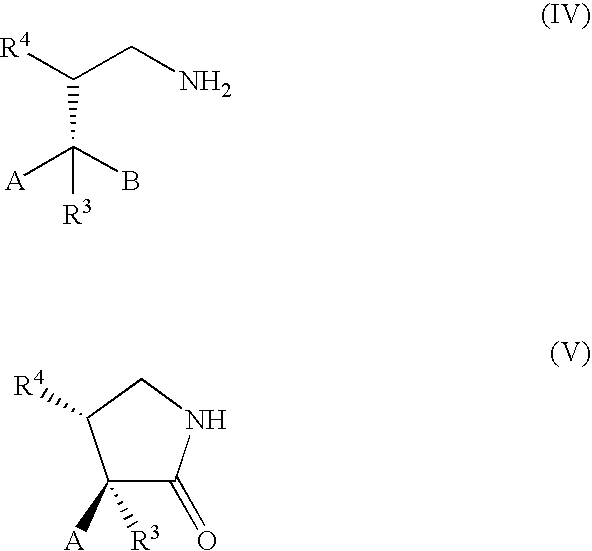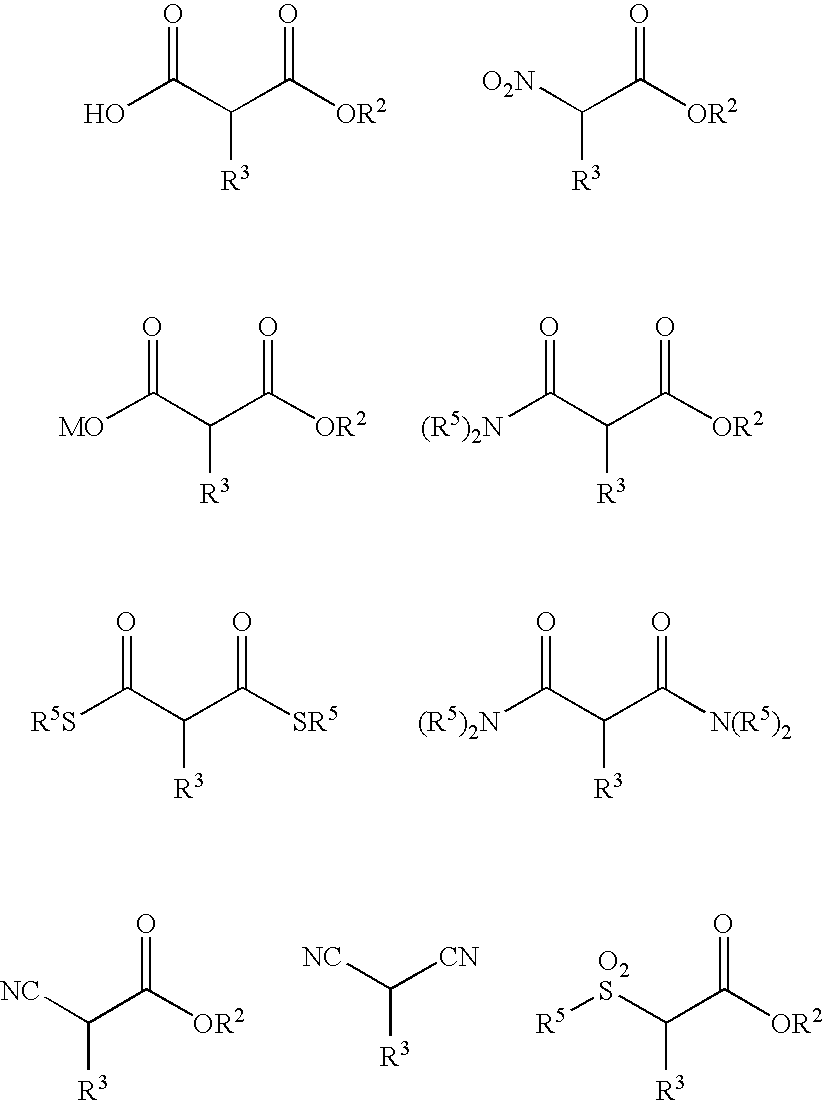Method of Preparing a Ring Compound Having Two Adjacent Chiral Centers
a chiral center and compound technology, applied in the field of preparing a chiral compound, can solve problems such as adversely affecting the reaction yield, and achieve the effect of high yield
- Summary
- Abstract
- Description
- Claims
- Application Information
AI Technical Summary
Benefits of technology
Problems solved by technology
Method used
Image
Examples
example 1
[0094] The following synthetic sequence illustrates the method of the present invention, wherein a stereogenic tertiary carbon is generated adjacent to a nonstereogenic quaternary carbon atom bearing diastereotopic groups by addition of an α-substituted malonate to a nitroolefin. Subsequent reduction of the nitro group to an amine group, followed by a stereoselective intramolecular cyclization of the amine compound produces a ring containing a chiral tertiary carbon atom adjacent to a chiral quaternary carbon atom.
dimethyl methylmalonate, Mg(OTf)2 (1 mol %) chiral ligand (1.1 mol %) N-methylmorphine 4A mol sieves, CHCl3 RT, 20 h, 87% yield, er=93.6:6.4 nitrostyrene (1) malonate (2) 1) Zn, HCl, EtOH MeO 50° C. 2) aq. NaOAc BnO CH2Cl2 MeO Me 3) DBU 66% yield, dr=91:7 pyrrolidinone ester (3)
[0095] The chiral ligand used in the above synthetic sequence was:
Preparation of 2-Benzyloxy-1-methoxy-4-(2-nitrovinyl)benzene (nitrostyrene (1))
[0096] Nitrostyrene (1), also known as 3-benzy...
example 2
[0106]
diethyl allylmalonate Mg(OTf)2 (1 mol %) chiral ligand (1.1 mol %) N-methylmorpholine 4A mol sieves, CHCl3RT, 20 h, (6) 72% yield, dr 91:9
[0107] The chiral ligand used in Example 2 was
Preparation of 2-[1R-phenyl-2-nitroethyl]-2-allylmalonic acid diethyl ester (7)
[0108] Chloroform (CHCl3), or alternatively chlorobenzene, (2.5 mL), the chiral ligand (enantiomer) (34.25 mg, 0.097 mmoles), and Mg(OTf)2 (28.25 mg, 0.088 mmoles) were added to a 25 mL flask. The resulting mixture was stirred for at least 20 minutes followed by the addition of water (0.0065 mL). The resulting mixture was stirred for at least 1 hour. The molecular sieves are an optional, but preferred, component, because stereoselectivity is improved when molecular sieves are present. Chloroform (7.5 mL) and powdered 4 Å molecular sieves (367.5 mg) were added to the reaction mixture, and stirring was continued for a minimum of 1 hour. Water content then was determined by Karl Fischer titration. If the water conten...
example 3
[0109] The above synthesis also can be performed using a racemic mixture of the ligand to generate a racemic mixture of a compound having a stereogenic carbon atom adjacent to a nonstereogenic carbon bearing diastereotopic groups.
diethyl allylmalonate Mg(OTf)2 (1 mol %) racemic ligand (1.1 mol %) N-methylmorpholine 4A mol sieves, CHCl3 RT, 20 h, (6) 79% yield 1) Zn, HCl, EtOH, 50° C. 2) aq. NaOAc, CH2Cl2 3) DBU 98% yield, dr 98:2 racemic pyrrolidinone ester (9)
Preparation of 2-Allyl-2-[1-phenyl-2-nitroethyl]-malonic acid diethyl ester (8)
[0110] Chloroform (150 mL), racemic ligand (1.97 g, 5.52 mmoles), and Mg(OTf)2 (1.62 g, 5.03 mmoles) were added to a 2 L flask. The mixture was stirred for at least 20 minutes followed by the addition of water (0.374 mL). The resulting mixture was stirred for at least 1 hour. Chloroform (450 mL) and powdered 4 Å molecular sieves (22.2 g) were added to the reaction mixture, and stirring was continued for a minimum of 1 hour. The water content th...
PUM
| Property | Measurement | Unit |
|---|---|---|
| Structure | aaaaa | aaaaa |
Abstract
Description
Claims
Application Information
 Login to View More
Login to View More - R&D
- Intellectual Property
- Life Sciences
- Materials
- Tech Scout
- Unparalleled Data Quality
- Higher Quality Content
- 60% Fewer Hallucinations
Browse by: Latest US Patents, China's latest patents, Technical Efficacy Thesaurus, Application Domain, Technology Topic, Popular Technical Reports.
© 2025 PatSnap. All rights reserved.Legal|Privacy policy|Modern Slavery Act Transparency Statement|Sitemap|About US| Contact US: help@patsnap.com



